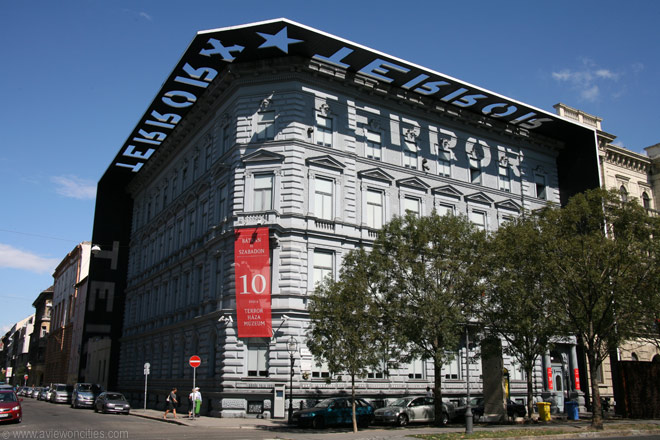Never Again
February 28, 2016

From the outside, the building at 60 Andrássy Street doesn't appear too different from the rest of the elegant, stately houses along what's known as the "Champs-Élysées" of Budapest, with the exception of two massive metal stencils spelling out "TERROR" attached to the roof. Once past the ticket booth, however, I'm immediately greeted by the barrel of a Soviet tank, behind which are thousands of black and white portraits above a panel with the word, "VICTIMS" emblazoned in both English and Hungarian.
A walk through this Hungarian secret police headquarters-turned-museum starts from the fourth floor, with accounts of life under the double occupation of both Germany and the Soviet Union during World War II, and continues descending deeper into tragedy on following floors. Heart-wrenching recollections of being sent to gulag labor camps under the Russians in the "peace" that followed war told a tale equally if not even more devastating than the previous era of German rule. In many ways, life in Hungary seemed to parallel that during the cultural revolution in China. Farmers were required to turn over their produce to the State; scholars, the wealthy, and religious leaders were persecuted; hundreds of thousands perished due to starvation. Not even members of the working class were safe—produce too much and you're asked for more, produce too little and you're punished. Interestingly enough, this pattern wasn't limited to the proletariat; even among the ranks of the secret police, the head of the secret police one day was often the one beneath the guillotine the next. As long as one group of people wielded enough power to bend laws to their will and infringe on the rights of citizens, nobody was safe, not even those who were running the whole operation.
Terror reigned, sparing none.
***
"The government is asking Apple to hack our own users and undermine decades of security advancements that protect our customers — including tens of millions of American citizens — from sophisticated hackers and cybercriminals."
I scrolled back to the top; while Apple CEO Tim Cook's words smacked of Orwellian dystopian fiction, there was no mistaking the date: February 16, 2016. That public letter, still featured on Apple's homepage, is the latest response to a series of requests from the United States government to Apple following the San Bernardino attack last December. In order to access the information on one of the shooter's phones, the FBI has requested that Apple build them a tool which they'll use to hack into the shooter's iPhone, and this one iPhone alone. However, as Cook says, "while the government may argue that its use would be limited to this case, there is no way to guarantee such control… And ultimately, we fear that this demand would undermine the very freedoms and liberty our government is meant to protect."
***
The lesson from the House of Terror is clear: if a government is willing to make an exception to the basic principles that form the core of a trusting, democratic society, then nobody, not even the enforcers themselves, is safe. Seventy years later, the reasons for creating a backdoor to the iPhone sound chillingly familiar: to identify and detain those who are a threat to the State. Yet, history is often the best window into the future, and we've seen what happens when a government has enough power to bend rules to their will; not even they can guarantee containment of that power.
***
The vertical box in front of me is a few inches taller and wider than I am. The thought that there's just enough room for me to stand in that box crosses my mind, and then it hits me: I'm not looking at a box, I'm looking at a windowless jail cell. I think back to visiting Alcatraz last summer, an island prison in San Francisco that had been shut down for being "inhumane." But at least those prisoners had company. They had communal meal times and exercise times, and even access to books. In the House of Terror, prisoners were tortured and kept in dark, cold isolation. They lacked laws and rights that would protect them from such atrocities. Their suffering was so deep and distraught that it was memorialized as a message for future generations: may you never repeat the same mistake.
BUDAPEST HUNGARY HOUSE OF TERROR APPLE SAN BERNARDINO POST-WWII OPINION TRAVEL